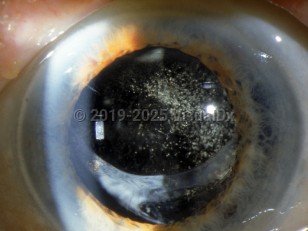Asteroid hyalosis - External and Internal Eye
Alerts and Notices
Important News & Links
Synopsis

Asteroid hyalosis (AH), originally named asteroid hyalitis, is one of the most common causes of vitreous opacification. It is a benign, usually unilateral, and usually asymptomatic condition characterized by numerous small, whitish opacities in the vitreous. In the primary care setting, AH is often discovered on a routine funduscopic exam with the direct ophthalmoscope.
The etiology of AH remains unknown, but the opacities are composed of hydroxyapatite-like calcium phosphate complexes and phospholipids. The condition is thought to be degenerative, as it is strongly associated with increasing age. It occurs in only up to 0.2% of people under 55 years of age, while the prevalence in those 75 years or older is 2%-3%. Overall, according to studies in the United States and Australia, AH occurs in about 1% of the population, about twice as often in men as in women, and without any racial predilection. AH has been inconsistently associated with diabetes, hypertension, and dyslipidemia.
AH is asymptomatic in the majority of patients, although large studies detailing the incidence and nature of symptoms (and accounting for conditions which could cause similar symptoms, such as posterior vitreous detachment) are lacking. Although longitudinal data is also lacking, this seems to be a slowly progressive (if not stationary) condition.
The etiology of AH remains unknown, but the opacities are composed of hydroxyapatite-like calcium phosphate complexes and phospholipids. The condition is thought to be degenerative, as it is strongly associated with increasing age. It occurs in only up to 0.2% of people under 55 years of age, while the prevalence in those 75 years or older is 2%-3%. Overall, according to studies in the United States and Australia, AH occurs in about 1% of the population, about twice as often in men as in women, and without any racial predilection. AH has been inconsistently associated with diabetes, hypertension, and dyslipidemia.
AH is asymptomatic in the majority of patients, although large studies detailing the incidence and nature of symptoms (and accounting for conditions which could cause similar symptoms, such as posterior vitreous detachment) are lacking. Although longitudinal data is also lacking, this seems to be a slowly progressive (if not stationary) condition.
Codes
ICD10CM:
H43.20 – Crystalline deposits in vitreous body, unspecified eye
SNOMEDCT:
95800001 – Asteroid Hyalosis
H43.20 – Crystalline deposits in vitreous body, unspecified eye
SNOMEDCT:
95800001 – Asteroid Hyalosis
Look For
Subscription Required
Diagnostic Pearls
Subscription Required
Differential Diagnosis & Pitfalls

To perform a comparison, select diagnoses from the classic differential
Subscription Required
Best Tests
Subscription Required
Management Pearls
Subscription Required
Therapy
Subscription Required
References
Subscription Required
Last Reviewed:10/27/2016
Last Updated:10/27/2016
Last Updated:10/27/2016

